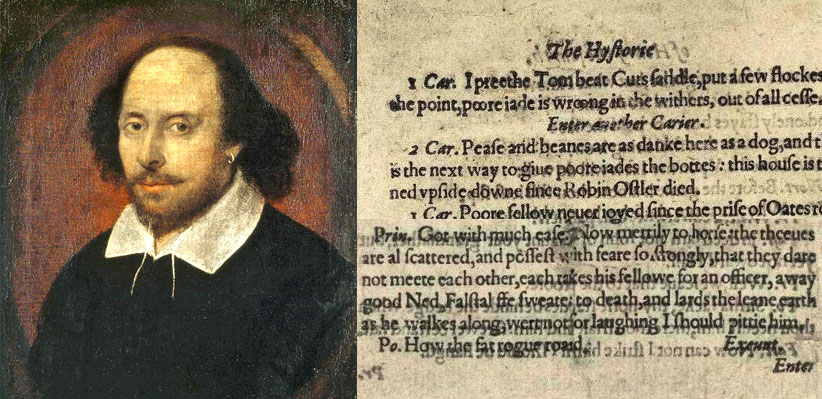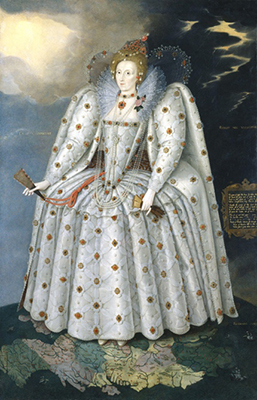 In honor of William Shakespeare we are celebrating the 400th anniversary of his death on April 23, 2016. What better way to do this, than by highlighting the writing done by first-year students in Associate Professor of English John Wesley’s first-year seminar, A Year in the Life of William Shakespeare? This first-year seminar in scholarly inquiry studies four remarkable plays Shakespeare wrote or saw into production in 1599, the same year he opened the Globe Theatre. In the first half of the course, students were introduced to the myriad ways in which Shakespeare’s 1599 plays are shaped by and give shape to the political and cultural intrigues of that year. In the second half of the course, students turned to a play (and year) of their own choosing, the historicist analysis of which is the basis of an independent research project. As part of this project, students were asked to prepare a blog post that reflected on aspects of Shakespeare’s life, a specific work, or a resource or organization associated with Shakespeare, or to provide a personal interpretation of a play. During the month of April, we’ll feature the posts from students that celebrate all things Shakespeare!
In honor of William Shakespeare we are celebrating the 400th anniversary of his death on April 23, 2016. What better way to do this, than by highlighting the writing done by first-year students in Associate Professor of English John Wesley’s first-year seminar, A Year in the Life of William Shakespeare? This first-year seminar in scholarly inquiry studies four remarkable plays Shakespeare wrote or saw into production in 1599, the same year he opened the Globe Theatre. In the first half of the course, students were introduced to the myriad ways in which Shakespeare’s 1599 plays are shaped by and give shape to the political and cultural intrigues of that year. In the second half of the course, students turned to a play (and year) of their own choosing, the historicist analysis of which is the basis of an independent research project. As part of this project, students were asked to prepare a blog post that reflected on aspects of Shakespeare’s life, a specific work, or a resource or organization associated with Shakespeare, or to provide a personal interpretation of a play. During the month of April, we’ll feature the posts from students that celebrate all things Shakespeare!
Congratulations to our wonderful first-year writers. For additional online resources about Shakespeare, check out these sites:
- British Library: http://www.bl.uk/
- Folger Shakespeare Library: http://www.folger.edu/
- Globe Theatre: http://www.shakespearesglobe.com
- Internet Shakespeare Editions: http://internetshakespeare.uvic.ca
- Shakespeare 400: http://www.shakespeare400.org/
Why Religion Matters: Shakespeare and the English Reformation
By Maddy McCombs
Religion, especially Christianity, is always apparent in Shakespeare’s works. From comedies like As You Like It, to infamous tragedies such as Hamlet, threads of the religious landscape of 16th century England can be found in the background of the plays that make him famous.
It is still quite a mystery as to what religion William Shakespeare actually identified with, as Protestants and Catholics alike continually find proof that he was one of them. Shakespeare was raised in a largely Protestant England: Queen Elizabeth I determined Protestantism to be the main religion of the nation shortly before the Bard’s birth with the Religious Settlement of 1559 (Trueman). However, Catholicism was always looming over England. After Henry VII first introduced the Protestant faith in England, Queen Mary fiercely reestablished Catholicism as the law of the land before quickly being switched again with Elizabeth I’s reign (Pettegree). When things finally settled again, Catholic churches and its paraphernalia were destroyed or covered in order to remove the corruption associated with the Catholic Church (Shapiro).
There is some evidence that Shakespeare’s father was Catholic because he was cited twice for not attending Protestant church services and there are reports of a will that allegedly served as a profession of his Catholic faith. Also, a Catholic relative on his mother’s side was executed for conspiracy to assassinate Queen Elizabeth (Miola).
Despite this information, Shakespeare’s own beliefs are not evident. Though the feud between the Protestant and Catholic faiths for ownership over this influential figure continues today, there is no proof that swings him either way. However, the struggles and questions raised throughout the reformation are very apparent through his plays.
Many aspects of the Reformation are extremely visible in Shakespeare’s work, Julius Caesar being a very potent example of current events mingling with recounts of the past. Just as Rome in Julius Caesar was at the crossroads between being a republic and an empire, 16th century England was at the crossroads between Catholicism and Protestantism. Also in Julius Caesar, the opening scene in which they celebrate Caesar is actually a holiday, the Feast of Lupercalia. As in Shakespeare’s life, there is confusion as to what should be celebrated: a national holiday or a religious one? Protestant England was moving away from religious holidays in favor of nationalistic ones, such as Accession Day celebrating Elizabeth’s rise to the throne (Shapiro). Elements of “white-washing” of Catholic churches are seen in Julius Caesar when two tribunes of Rome remove the decorations lining the streets for Caesar’s triumphant return from exiling Pompey, another Roman leader of the time.
Though Julius Caesar provides some of the best allusions to the conflict of the Reformation, many other plays do so as well. The ghost of Hamlet’s father can be seen to be the specter of Catholicism haunting the new Protestant way of life. Othello is seen to show the evils of Protestant faith in the villainous Iago countering the Catholicism of Desdemona and Othello himself.
William Shakespeare did not shy away from addressing the conflicts of his time in many of his plays. Though we never get a clear picture as to what side of the Reformation he personally found himself on, we are still to this day able to see the themes of censorship, tyranny, and control that so often presented itself in his lifetime.
For further reading on the role religion in Shakespeare’s plays, I highly suggest Shakespeare and the Culture of Christianity in Early Modern England, edited by Dennis Taylor and David Beauregard
Bibliography
Miola, Robert S. “Shakespeare’s Religion.” First Things. First Things, May 2008. Web. 01 Mar. 2016.
Pettegree, Andrew. “The English Reformation.” BBC News. BBC, 17 Feb. 2011. Web. 01 Mar. 2016.
Shapiro, James. “Is This a Holiday?” A Year in the Life of William Shakespeare. New York: Harper Perennial, 2006. 138-70. Print.
Trueman, Chris. “The Religious Settlement of 1559” The History Learning Site, 17 Mar. 2015. Web. 01 Mar. 2016.
Pictures:
Church destroyed during the English Reformation: http://supremacyandsurvival.blogspot.com/2014/09/destruction-and-iconclasm-in-english.html
The Ditchley Portrait of Queen Elizabeth I by Marcus Gheeraerts the Younger c 1592
https://en.wikipedia.org/wiki/Portraiture_of_Elizabeth_I_of_England#/media/File:Queen_Elizabeth_I_(%27The_Ditchley_portrait%27)_by_Marcus_Gheeraerts_the_Younger.jpg
Destruction of religious images in Zurich, 1524
https://upload.wikimedia.org/wikipedia/commons/2/2b/Destruction_of_icons_in_Zurich_1524.jpg



